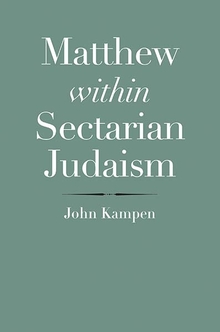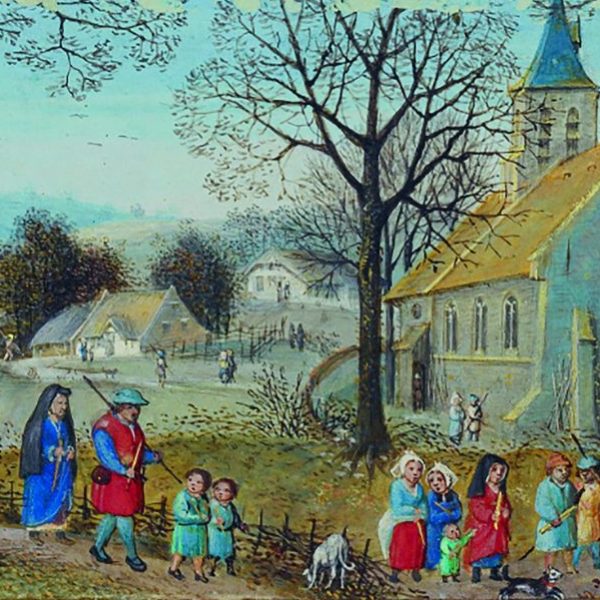The Gospel of Matthew: Within and Without Judaism
John Kampen—
Matthew is usually regarded as the “most Jewish gospel” since it bears evidence of more direct and more informed interaction with texts, concepts, and institutions usually identified with Jewish life at the conclusion of the first century CE. While the noted connections have not always been well-informed by the best available critical analyses in the study of first century Judaism, particularly with regard to the employment of rabbinic texts, they do indicate the importance of the study of the first gospel within the context of the material that informs our understanding of that period in Jewish life. Since I am among the majority of scholars who do not consider Matthew the first gospel to be written, its Jewish nature and content challenges a simple paradigm that assumes a linear progression from the religion of Jesus as Jewish to a non-Jewish entity known as Christianity, in other words, a simplistic parting of the ways paradigm.
This simple observation demonstrates the complex relationship with Judaism evident in the texts of the early Christian movement. While it might be possible to demonstrate a trajectory of a parting of the ways in some texts, the more appropriate identification evident in a text like Matthew is a continuing process of definition and redefinition in relationship to contemporary Judaism. Such a process is informed by the recognition among a growing number of scholars of Galilee or lower Syria as the locale for the composition of the first gospel rather than the site of Antioch traditionally held as the default position by the majority of Matthean scholars. Extensive archaeological excavation coupled with the critical examination of relevant texts has resulted in a much more complex portrayal of this region as a complex multi-cultural area composed of a complex of rural villages and urban centers reflecting the Hellenistic cultural legacy as well as the military and political arms of Roman Imperial hegemony. It is this same environment within which the Rabbinic movement developed a few centuries later. This makes it not only possible but necessary to read the gospel of Matthew within that Syro-Palestinian religious, cultural, and political milieu.
The difference such a reading makes can be illustrated with the treatment of the topic of Jewish law. Earlier scholarship frequently set up Matthew as the proponent of an argument for continuity with the law to address the concerns of Jewish-Christians in the early Christian movement. This was proposed as a contrast to Paul who argued for freedom from the law in the early Christian movement. These writings were proposed as representative of conflicting viewpoints within the early Christian movements. Whether this is a correct reading of Paul has certainly been called into question, however that is not the topic of this discussion. Reading Matthew within the context of Syro-Palestinian Jewish literature such as the Dead Sea Scrolls, the Rabbinic literature, Josephus, and apocalyptic literature points in a different direction. From a sociological perspective such a reading permits Matthew to be understood as the product of a Jewish sect related to other sectarian developments in the first century CE. In such a reading the validity of the law as a whole is never questioned, the issue is the interpretation of the stipulations of the law. The question is, how should a good Jew who wants to live life in a manner pleasing to God behave? The author of Matthew makes the case just as adherents of other groups of Jews such as the Pharisees, the Sadducees, and the Essenes, as well as other groups not named in our literature, made their points about the requirements of the Torah and why their interpretation was valid and important. Matthew’s interlocutors are the teachers and leaders of these other Jewish groups rather than the apostles of an opposing group within the proto-Christian movement.
Matthew remains primary and influential through the Reformation era up to the advent of modern biblical criticism when the priority of Mark as the first gospel became the reigning hypothesis. It also was held to be the oldest of the gospels, the first to be written. Presumably this had to do with the continuing belief that it had originally been composed in Aramaic or Hebrew and translated in contrast to the other gospels which would have been written in Greek. This antiquarian argument contributed to its authoritative stance. What is lacking in subsequent recorded Christian history is any evidence that this particular argument of Matthew took hold within Jewish communities. It rather appears that the Pauline message supported by the basic narrative of Jesus common to the four gospels and especially the account of the crucifixion held sway. The particular Jewish content and argumentation of Matthew gets subsumed into various versions of this broader Christian message and begins to play a role in the primarily Gentile Christian movement as Matthew serves as an authoritative source for its theology and ethics. For example, Matthew now does become an authoritative source for discussions of the role of law within Christian doctrine. Matthew’s authority is also employed in the engagement with challenges from Jewish interlocutors within and outside of its circles.
This Jewish composition uprooted from its Jewish context now serves a Gentile church attempting to define itself against its Jewish origins. In the course of these two millennia, the original Jewish composition is delinked from its Jewish context. In so doing, it is no longer considered to be a product of the Jewish experience of the first century. It is then no longer read with its original addressees in mind, the Jews of first-century Syro-Palestine, and regarded as part of their history. Matthew remains central for defining the relationship of the followers of Jesus to Judaism, regardless of whether Jews are present for the debate.
John Kampen is an eminent scholar of the Dead Sea Scrolls, the New Testament, and Jewish history of the Greco-Roman period. He is the Van Bogard Dunn Professor of Biblical Interpretation at the Methodist Theological School in Ohio.
Further Reading

Featured Photo by Chuttersnap on Unsplash


























